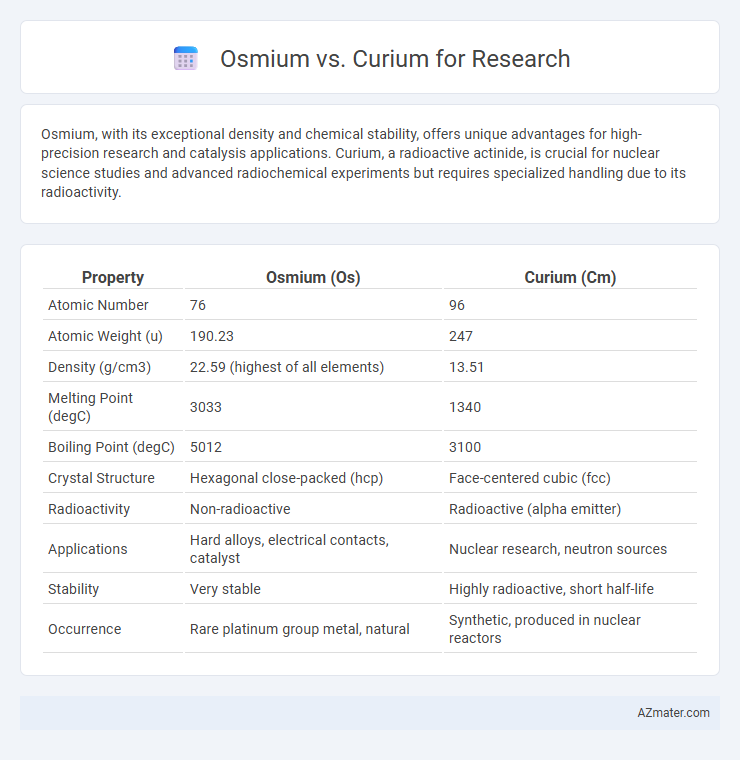Osmium, with its exceptional density and chemical stability, offers unique advantages for high-precision research and catalysis applications. Curium, a radioactive actinide, is crucial for nuclear science studies and advanced radiochemical experiments but requires specialized handling due to its radioactivity.
Table of Comparison
| Property | Osmium (Os) | Curium (Cm) |
|---|---|---|
| Atomic Number | 76 | 96 |
| Atomic Weight (u) | 190.23 | 247 |
| Density (g/cm3) | 22.59 (highest of all elements) | 13.51 |
| Melting Point (degC) | 3033 | 1340 |
| Boiling Point (degC) | 5012 | 3100 |
| Crystal Structure | Hexagonal close-packed (hcp) | Face-centered cubic (fcc) |
| Radioactivity | Non-radioactive | Radioactive (alpha emitter) |
| Applications | Hard alloys, electrical contacts, catalyst | Nuclear research, neutron sources |
| Stability | Very stable | Highly radioactive, short half-life |
| Occurrence | Rare platinum group metal, natural | Synthetic, produced in nuclear reactors |
Introduction to Osmium and Curium
Osmium, a dense transition metal with atomic number 76, is primarily utilized for its hardness and corrosion resistance in advanced material research. Curium, atomic number 96, is a synthetic radioactive actinide employed in nuclear science for studying radioactive decay and transmutation processes. Research comparing osmium and curium focuses on their distinct physical and chemical properties, enabling advancements in materials science and nuclear technology.
Elemental Properties Comparison
Osmium, a dense transition metal in the platinum group, exhibits a high melting point of 3,045degC and exceptional hardness, making it valuable in materials science research. Curium, an actinide element with atomic number 96, is highly radioactive and primarily studied for its nuclear properties and applications in nuclear reactors. The stark contrast between osmium's stable, metallic characteristics and curium's radioactive behavior defines their distinct research roles in elemental chemistry and nuclear science.
Occurrence and Availability
Osmium, a dense transition metal primarily found in platinum ores, occurs in the Earth's crust at approximately 0.001 to 0.005 ppm, making it relatively rare but more accessible for research due to established mining and extraction methods. Curium, a synthetic actinide element produced in nuclear reactors through neutron bombardment of plutonium or americium, does not occur naturally and is only available in minute quantities for research, requiring specialized facilities and high costs. The limited natural occurrence of osmium contrasts sharply with curium's complete synthetic origin, heavily influencing their availability and handling in scientific investigations.
Synthesis Methods and Purity
Osmium synthesis primarily involves the extraction from naturally occurring platinum ores through complex refining processes including chemical separation and zone refining to achieve high purity suited for research applications. Curium, a synthetic actinide produced in nuclear reactors via neutron capture and beta decay of plutonium isotopes, requires meticulous radiochemical separation and purification steps using ion exchange chromatography to reach research-grade purity. The distinct synthesis pathways impact the achievable purity levels; osmium benefits from geologic sources enabling milligram to gram-scale quantities with >99.9% purity, while curium's radionuclide nature limits production quantities and demands stringent radiopurity controls for safe handling in experimental investigations.
Chemical Behavior and Reactivity
Osmium exhibits exceptional chemical stability and low reactivity, characterized by its resistance to oxidation and corrosive agents, making it ideal for high-precision catalysis and materials research. Curium, a synthetic actinide, shows high radioactivity with complex oxidation states and significant chemical reactivity, particularly in forming coordination compounds and studying nuclear fuel cycles. Understanding the contrasting behavior of osmium's inertness versus curium's radiochemical activity is crucial for tailoring experimental approaches in inorganic chemistry and nuclear science.
Applications in Scientific Research
Osmium is prized in scientific research for its exceptional density and hardness, making it ideal for applications in microscopy, catalysis, and alloy production. Curium, a radioactive actinide, is primarily used in nuclear research and as a neutron source in radiography and space exploration. The distinct properties of osmium enable advancements in material science, while curium's radioactivity supports breakthroughs in nuclear physics and radiation-based technologies.
Safety and Handling Precautions
Osmium, a dense transition metal, requires strict handling precautions due to the toxic osmium tetroxide it can produce, necessitating well-ventilated areas and protective equipment to avoid serious respiratory and skin hazards. Curium, a radioactive actinide, demands rigorous safety protocols including remote handling, shielding, and containment to mitigate radiation exposure risks from alpha particles and potential contamination. Research involving osmium emphasizes chemical toxicity control, while curium handling prioritizes radiological safety and secure waste management.
Cost and Accessibility for Laboratories
Osmium, a rare and dense transition metal, is costly due to its limited natural abundance and complex extraction processes, making it less accessible for widespread laboratory research. Curium, a radioactive actinide element primarily produced in nuclear reactors, bears high costs linked to its synthesis and strict regulatory controls, significantly restricting its availability to specialized research facilities. Laboratories aiming to study these elements often face substantial financial and logistical challenges, with osmium favored for material science applications and curium reserved for nuclear and radiological research.
Environmental Impact and Disposal
Osmium, a dense, naturally occurring metal, poses significant environmental risks due to its toxic osmium tetroxide compound, which requires careful handling and disposal to prevent harmful atmospheric release. Curium, a synthetic radioactive element, presents more complex challenges with long-term radioactive contamination and requires specialized containment and disposal protocols to minimize environmental impact. Research facilities prioritize advanced waste management techniques for curium's radioactive byproducts, while osmium disposal demands strict chemical safety measures to protect ecosystems.
Summary: Choosing Between Osmium and Curium for Research
Osmium, a dense, stable transition metal, offers high durability and excellent catalytic properties beneficial for materials science and chemical research. Curium, a radioactive actinide element, is primarily utilized in nuclear research and radiometric dating due to its alpha-emitting isotopes and unique nuclear properties. Selecting between osmium and curium depends on the research focus: osmium excels in physical and catalytic studies, while curium is essential for advanced nuclear and radiochemical investigations.

Infographic: Osmium vs Curium for Research
 azmater.com
azmater.com